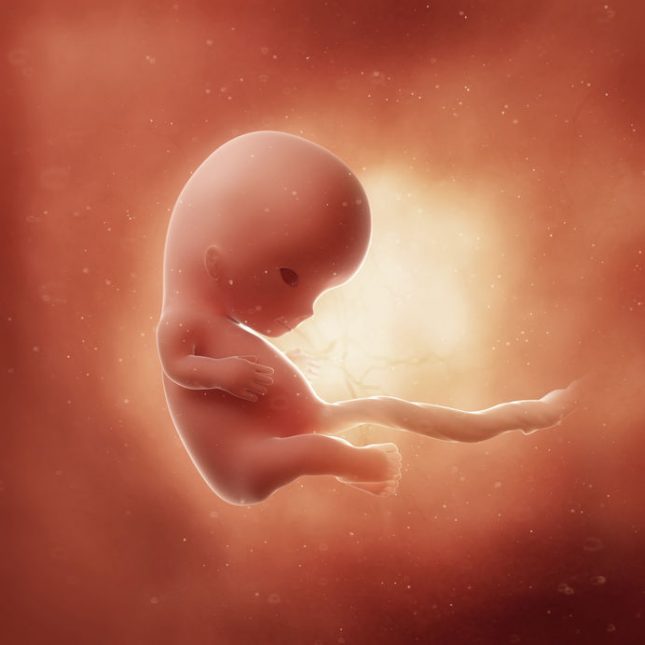In association with professional midwife experts at birthEd, find out everything you need to know about pregnancy at 10 weeks, including how your baby is growing, changes to expect in your body and pregnancy health, nutrition and wellness advice.
| Week 9 |
Week 11 |
10 Weeks Pregnant – Your baby, your body & you
Your Baby
Your baby is around 3.5cm to 4cm – and is as big as a strawberry!

Its liver has started making red blood cells and the spleen will take over most of this role soon. Your baby’s head is large in comparison to the rest of its body and his brain is growing at a phenomenal rate building neural pathways so that it can move their body around the womb.
Its eyelids are nearly fully formed and the eyes can react to light. Your baby’s eyelids will close soon and they will open again around the 26-28th week mark.
Your baby’s bones and ligaments are starting to form and even the little joints are beginning to work too. Your baby is no longer an embryo – it is a fetus! Over the following 30 weeks of pregnancy all these organs will continue to grow and mature. It’s incredible to think your little one is just a very small version of the baby you’ll have in your arms in 6+ months.
Your Body
Your body is working so hard to grow a little human. Your pregnancy symptoms may continue to persist but hang in there, this is not forever.
Your ever growing uterus is now the size of a grapefruit and you may begin to notice changes in the shape of your body – or this may come later. Your uterus is still tucked in your pelvis but you might find that you’re more comfortable wearing a stretchy waistband. Perhaps it’s time to think about some more comfortable clothes?
During pregnancy your volume of blood to be can increase by almost 50%. This process has already begun so if your skin is thin and fair you will have likely noticed an increase in veins across your breasts, tummy and thighs.
These veins are crucial for delivering blood and nutrients around your body and to your baby. Visible veins are different to varicose veins which are also common in pregnancy but are usually caused later on in pregnancy when the weight of the uterus applies pressure to a large vein, the vena cava. We’ll cover this more in Week 21.
You
Growing a baby can be exhausting and pregnancy fatigue, especially in your first and third trimester, is completely normal. Remember, it’s not just your baby that’s growing at a rapid rate but also your baby’s life source, the magnificent placenta.
This week, we encourage you to really tune in with your body’s wants and needs. Listen to your body when it tells you it’s time to rest. Although you may not look pregnant you are so deserving of a cat nap to restore some energy.
Notice when you may be compensating caffeine and other stimulants for rest – take a nap if you can, instead of reaching for chocolate at 4pm. When you are less wired and more rested you will notice a significant difference in your productivity.
Resting can also help to support your diet. When you are exhausted and drained you are more likely to reach for junk food and fast releasing carbohydrates that won’t sustain you long term. You may find when you are better rested you crave more substantial foods that release energy slowly and keep you feeling good for longer.
Preparing for Baby
Between week 10 and 14, you may be offered an elective NIPT (non-invasive prenatal testing). NIPT is a blood test that screens pregnancies for chromosomal abnormalities including Down syndrome, Edwards syndrome and Patau syndrome.
This test is not currently government funded and costs $650. However, it offers a more comprehensive and accurate understanding of your baby’s chromosomes. It is often strongly suggested if a mother is high risk to these genetic disorders. This prenatal test can also offer information regarding whether you are carrying a boy or a girl, this is even before you can tell on an ultrasound.
Speak with your LMC about whether the NIPT is right for you. You may like to wait for results from a Nuchal Translucency measure which is usually assessed at 12-13+6 weeks. We’ll cover more information about the nuchal translucency scan in Week 12.
Your Relationships
It is not too early to start thinking about what your family will look like when your little one arrives. This week we encourage you to sit down with your partner, use techniques like brainstorming and visualising, and have a think about how you’d like life to look.
Despite how clever our brains are, they actually don’t know the difference between thoughts and reality. Your brain will fire off a signal to send out the same hormonal response to a thought that it will to an event actually occurring.
So when you imagine that special moment of meeting your new baby, your body will respond by releasing endorphins. This is a great tool to allow you and your partner to feel more connected to each other and to the growing baby inside you.
If it feels too soon to be thinking like this then trust that, when your baby starts to grow bigger it’ll be hard to not think about that precious moment!
This Week’s Preparation
Speak with your LMC about whether the NIPT is right for you.
Listen to your body and heed the signals to rest – rather than reach for a stimulant like caffeine or sugar.
Begin to think about more comfortable clothes – elastic waistbands and comfortable tops.
Eat small nutritious meals more frequently to avoid morning sickness.
Take your prenatal vitamins, iodine, additional folic acid supplement and consider an iron supplement.
Cut back on your caffeine intake.
Increase your consumption of fruit and vegetables and cut back refined sugar and trans-fats.
Back to 52 Weeks of pregnancy.







